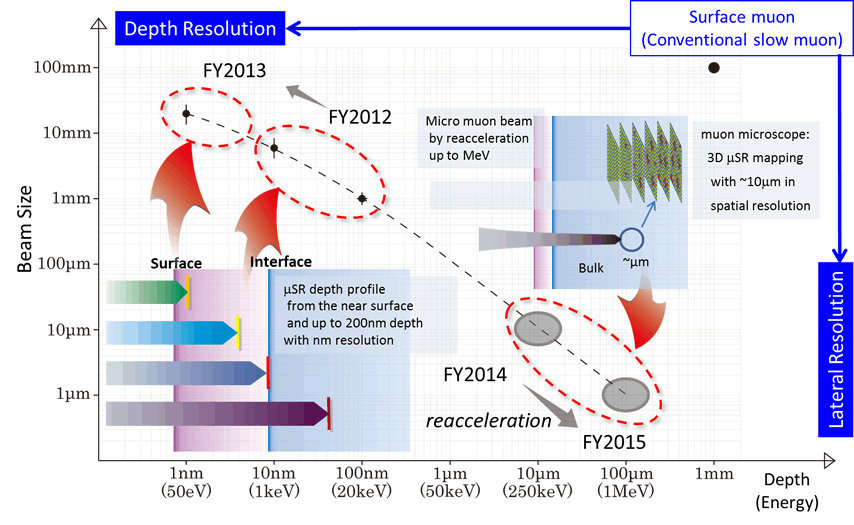

For the function of materials and living substances, the boundary conditions such as interfaces play an important role. The interface also provides a place for advancing superconductivity and exotic materials. In the present research area, by establishing a new real-space imaging method by the Ultra Slow Muon Microscope, the fundamental mechanism of various phenomena in physics, chemistry and biology will be investigated in order to promote new academic fields for material design.
Positive muons, which are produced by accelerators, are naturally polarized, namely, spin oriented in the same direction, which can be used to probe with a high sensitivity the behavior of the surrounding atoms and molecules at the stopping sites in the materials.
The Ultra Slow Muon Microscope will be the first experimental instrumentation in the world with the following two excellent capabilities, which are essential for materials and life science experimental research: (1) “Utra-Slow muon” for depth profiling with nanometer depth resolution, and (2) “high-density Micro-Beam” for three-dimensional imaging inside materials with micrometer spatial resolution.
The research area consists of four core research groups and individual researchers;
(A01) Establishment of the Ultra Slow Muon Microscope and micro-scale muSR.
PI: Y.Miyake(KEK-IMSS, J-PARC)
(A02) Spin transport and catalytic reactions in the boundary regions. PI: Eiko Torikai
(A03) Heterogeneous electron correlation in the surface-bulk boundary and across thin layered structures. PI: Ryosuke Kadono(KEK-IMSS, J-PARC)
(A04) Extreme cooling and sharpening of the beam towards the “new physics” frontier beyond the standard model. PI: Masahiko Iwasaki(RIKEN Nishina Center for Accelerator-Based Science)
It is highly expected that the local and overall understanding of electronic states associated with surface, interface and thin film phenomena will bring us a revolutionary progress in both fundamental research and applied research related to Green Innovation.
Fortunately, this remarkable project can only be realized in Japan based upon both the world-strongest pulsed muon beam available in a year at J-PARC and the world-strongest pulsed lasers developed at RIKEN. In the present project, in order to complete the best Ultra Slow Muon Microscope, all the experience and expertise are assembled from the fields of condensed matter, chemistry, life science, particle/nuclear physics, accelerator and laser science. The project will contribute to establish the center for interface science at J-PARC.
At the same time, with the help of related institutions, the Trial Use beam time will be arranged to encourage the use of the Ultra Slow Muon Microscope by fresh muon users, researchers in different fields and industrial users.
Ultra slow muon, muSR, spin-imaging, surface and interface, thin film, all solid laser, resonance ionization, Lyman-α laser, magnetism, superconductivity, semiconductor, insulator, actinide, molecular crystal, battery materials.